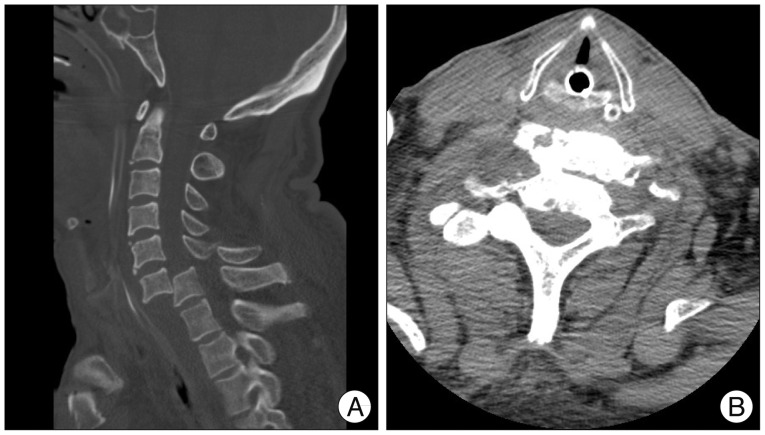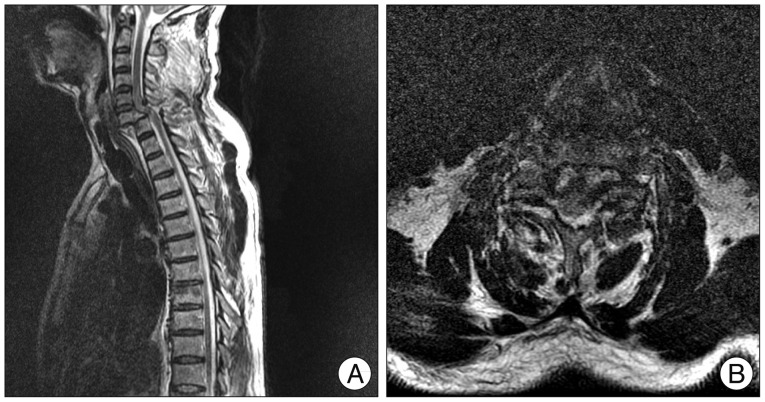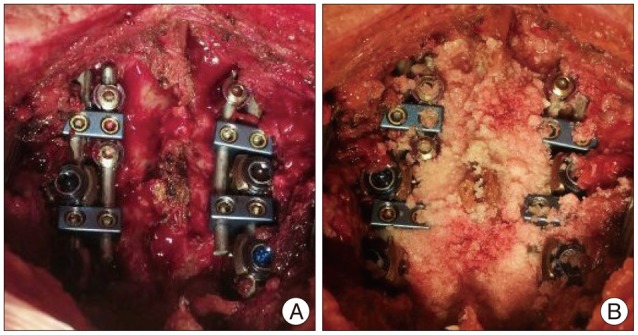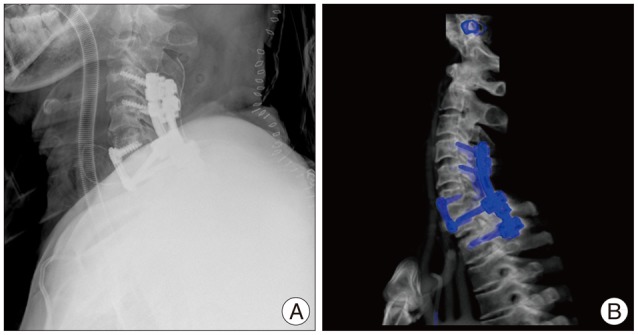J Korean Neurosurg Soc.
2014 May;55(5):289-292. 10.3340/jkns.2014.55.5.289.
Management of Traumatic C6-7 Spondyloptosis with Cord Compression
- Affiliations
-
- 1Department of Neurosurgery, Kyung Hee University Hospital, Seoul, Korea.
- 2Department of Neurosurgery, Kyung Hee University Hospital at Gangdong, Seoul, Korea. apuzzo@hanmail.net
- KMID: 2018037
- DOI: http://doi.org/10.3340/jkns.2014.55.5.289
Abstract
- A case of total spondyloptosis of the cervical spine at C6-7 level with cord compression is described in a 51-year-old male. Because the bodies of C6 and 7 were tightly locked together, cervical traction failed. Then the patient was operated on by a posterior approach. Posterior stabilization and fusion were performed by C4-5 lateral mass and C7-T1 pedicle screw fixation and rod instrumentation with bridging both C4-5's rods to the C7-T1's extended ones. After C6 total laminectomy and foraminotomy, the C6 body was returned to its proper position. Secondly, anterior stabilization and fusion were performed by C6-7 discectomy with a screw-plate system. A postoperative lateral plain radiograph showed good realignment. In this case, we report the clinical presentation and discuss the surgical modalities of C6-7 total spondyloptosis and the failed close reduction.
Figure
Reference
-
1. Acikbas C, Gurkanlar D. Post-traumatic C7-T1 Spondyloptosis in a patient without neurological deficit : a case report. Turk Neurosurg. 2010; 20:257–260. PMID: 20401855.2. Akay KM, Ersahin Y, Tabur E. Cervical spondyloptosis : a case report. Minim Invasive Neurosurg. 2002; 45:169–172. PMID: 12353166.3. Bhojraj SY, Shahane SM. Posttraumatic cervical spondyloptosis at C6-7 with late-onset cord compression : a new clinical entity. Case report. J Neurosurg. 1992; 77:792–794. PMID: 1403125.
Article4. Dahdaleh NS, Dlouhy BJ, Greenlee JD, Smoker WR, Hitchon PW. An algorithm for the management of posttraumatic cervical spondyloptosis. J Clin Neurosci. 2013; 20:951–957. PMID: 23702373.
Article5. Dunlap BJ, Karaikovic EE, Park HS, Sokolowski MJ, Zhang LQ. Load sharing properties of cervical pedicle screw-rod constructs versus lateral mass screw-rod constructs. Eur Spine J. 2010; 19:803–808. PMID: 20119837.
Article6. Garneti N, Dunn D, El Gamal E, Williams DA, Nelson IW, Sandemon DR. Cervical spondyloptosis caused by an aneurysmal bone cyst : a case report. Spine (Phila Pa 1976). 2003; 28:E68–E70. PMID: 12590221.7. Goffin J, Grob D. Spondyloptosis of the cervical spine in neurofibromatosis. A case report. Spine (Phila Pa 1976). 24:1999; 587–590. PMID: 10101826.8. Johnston TL, Karaikovic EE, Lautenschlager EP, Marcu D. Cervical pedicle screws vs. lateral mass screws : uniplanar fatigue analysis and residual pullout strengths. Spine J. 2006; 6:667–672. PMID: 17088197.
Article9. Lee DG, Hwang SH, Lee CH, Kang DH. Clinical experience of traumatic C7-T1 spondyloptosis. J Korean Neurosurg Soc. 2007; 41:127–129.10. Mamindla RK, Kumar A, Bhattacharjee S, Sahu BP. A novel case of "ambulatory" cervical spondyloptosis : case report with literature review. Eur Spine J. 2014; 23(Suppl 2):161–166. PMID: 23708939.
Article11. Menku A, Kurtsoy A, Tucer B, Oktem IS, Akdemir H. The surgical management of traumatic C6-C7 spondyloptosis in a patient without neurological deficits. Minim Invasive Neurosurg. 2004; 47:242–244. PMID: 15346323.
Article12. Ozdogan C, Gogusgeren MA, Dosoglu M. Posttraumatic cervical spondyloptosis 'Case Report'. Turk J Trauma Emerg Surg. 1999; 5:46–48.13. Song KC, Cho KS, Lee SB. Congenital defect of the posterior arch of cervical spine : report of three cases and review of the current literature. J Korean Neurosurg Soc. 2010; 48:294–297. PMID: 21082064.
Article14. Srivastava SK, Agrawal KM, Sharma AK, Agrawal MD, Bhosale SK, Renganathan SR. C3-C4 spondyloptosis without neurological deficit-a case report. Spine J. 2010; 10:e16–e20. PMID: 20620981.
Article15. Tumialán LM, Dadashev V, Laborde DV, Gupta SK. Management of traumatic cervical spondyloptosis in a neurologically intact patient : case report. Spine (Phila Pa 1976). 2009; 34:E703–E708. PMID: 19730203.
- Full Text Links
- Actions
-
Cited
- CITED
-
- Close
- Share
- Similar articles
-
- Clinical Experience of Traumatic C7-T1 Spondyloptosis
- The Surgical Management of Traumatic C6-C7 Spondyloptosis
- Partial Vertebrectomy in Neglected Spondyloptosis at the T10–11 Level: A Case Report
- Management of Traumatic Cervical Spondyloptosis with an Unsealable Dura Tear: A Case Report
- Traumatic Cervical Spondyloptosis of the Subaxial Cervical Spine: A Case Series with a Literature Review and a New Classification





